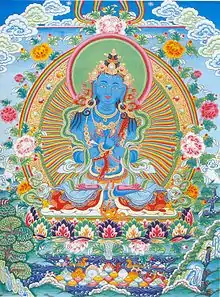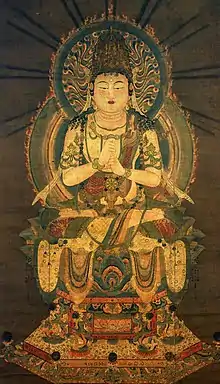Adi-Buddha
In Vajrayana Buddhism, the Ādi-Buddha (Tibetan: དང་པོའི་སངས་རྒྱས།, Wylie: dang po'i sangs rgyas, THL: Dangpö Sanggyé ), is the "First Buddha" or the "Primordial Buddha."[1] Another common term for this figure is Dharmakāya Buddha.[2]


| Part of a series on |
| Vajrayana Buddhism |
|---|
 |
The term emerges in tantric Buddhist literature, most prominently in the Kalachakra.[3] "Ādi" means "first", such that the Ādibuddha was the first to attain Buddhahood.[3] "Ādi" can also mean “primordial,” not referring to a person but to an innate wisdom that is present in all sentient beings.[3]
In the Indo-Tibetan Buddhist tradition
In Indo-Tibetan Buddhism, the term Ādibuddha is often used to describe the Buddha Samantabhadra (in Nyingma), Vajradhara or Kalachakra (in the Sarma schools).[3][4]
There was also a tradition in India which saw Mañjuśrī as the Ādibuddha, as exemplified by Vilāsavajra's commentary to the Mañjuśrīnāmasamgīti.[5] Vilāsavajra states in his commentary:
The gnosis-being Mañjuśrī is not the bodhisattva who is the master of the ten stages (bhumi). Rather, he is the non-dual gnosis (advayajñāna), the perfection of wisdom (prajñāpāramitā) itself.[6]
According to Anthony Tribe, this tradition may have influenced the Jñānapāda tradition of Guhyasamāja exegesis, which places Mañjuvajra (a tantric form of Mañjuśrī) at the center of the Guhyasamāja mandala.[7]
Vesna Wallace describes the concept of Ādibuddha in the Kalachakra tradition as follows:
when the Kalacakra tradition speaks of the Ādibuddha in the sense of a beginningless and endless Buddha, it is referring to the innate gnosis that pervades the minds of all sentient beings and stands as the basis of both samsara and nirvana. Whereas, when it speaks of the Ādibuddha as the one who first attained perfect enlightenment by means of imperishable bliss, and when it asserts the necessity of acquiring merit and knowledge in order to attain perfect Buddhahood, it is referring to the actual realization of one's own innate gnosis. Thus, one could say that in the Kalacakra tradition, Ādibuddha refers to the ultimate nature of one's own mind and to the one who has realized the innate nature of one's own mind by means of purificatory practices.[8]
According to Jim Valby (translator of the Kunjed Gyalpo), in the Dzogchen tradition, Samantabhadra ("All-Good") is not a God but "our timeless Pure Perfect Presence beyond cause and effect."[9] The Guhyasamāja Tantra calls Vajradhāra (the "Vajra holder"),
"the Teacher, who is bowed to by all the Buddhas, best of the three vajras, best of the great best, supreme lord of the three vajras."[4]
Alex Wayman notes that the Pradīpoddyotana, a tantric commentary, explains that the "three vajras" are the three mysteries of Body, Speech, and Mind, which are the displays of the Ādibuddha. Wayman further writes:
"Tsong-kha-pa's Mchan-'grel explains the "lord of body": displays simultaneously innumerable materializations of body; "lord of speech": teaches the Dharma simultaneously to boundless sentient beings each in his own language; "lord of mind": understands all the knowable which seems impossible.[1]
According to the 14th Dalai Lama, the Ādibuddha is also seen in Mahayana Buddhism as representation of the universe, its laws and its true nature, as a source of enlightenment and karmic manifestations and a representation of the Trikaya.[10]
In East Asian Buddhism

In Chinese Esoteric Buddhism, and in Japanese Shingon, the Ādibuddha is typically considered to be Mahāvairocana.[3] In Japanese Shingon, the terms Primordial body (honji-shin) and Dharmakaya principle (riho-jin) are used to refer to the Ādibuddha. It is also associated with the letter A, the first letter of the Siddham Alphabet, and is seen as the source of the universe.[11]
Meanwhile, in the Japanese Amidist or "Pure Land" sects, Amitabha Buddha ("Amida") is seen as being the "Supreme Buddha" or the One Original buddha (ichi-butsu).[12]
The Lotus Sutra states that Sakyamuni Buddha is the "Eternal Buddha." This was the view of Nichiren, and of some modern Nichiren Buddhist schools.[13] However, the Nikko-lineage, specifically the Soka Gakkai and Nichiren Shoshu, regard Nichiren himself as the Ādibuddha and dispute the contentions of other sects that view him as a mere bodhisattva.[14]
See also
Notes
- Wayman, Alex (2013). The Buddhist Tantras: Light on Indo-Tibetan Esotericism. Routledge. p. 53. ISBN 978-1-135-02922-7.
- Gray, David (2007), The Cakrasamvara Tantra (The Discourse of Sri Heruka): Śrīherukābhidhāna: A Study and Annotated Translation (Treasury of the Buddhist Sciences), p. 32.
- Buswell, Robert E.; Lopez, Jr., Donald S. (2013). The Princeton dictionary of Buddhism. Princeton: Princeton University Press. ISBN 9781400848058. Entry on "ādibuddha".
- Wayman, Alex; The Buddhist Tantras: Light on Indo-Tibetan esotericism, page 53.
- Tribe, Anthony (2016). Tantric Buddhist Practice in India: Vilāsavajra’s commentary on the Mañjuśrī-nāmasaṃgīti, p. 3. Routledge.
- Tribe, Anthony (2016). Tantric Buddhist Practice in India: Vilāsavajra’s commentary on the Mañjuśrī-nāmasaṃgīti, p. 8. Routledge.
- Tribe, Anthony (2016). Tantric Buddhist Practice in India: Vilāsavajra’s commentary on the Mañjuśrī-nāmasaṃgīti, p. 8. Routledge.
- Wallace, Vesna (2001). The Inner Kalacakratantra: A Buddhist Tantric View of the Individual, p. 18. Oxford University Press.
- Valby, Jim (2016). Ornament of the State of Samantabhadra - Commentary on the All-Creating King - Pure Perfect Presence - Great Perfection of All Phenomena. Volume One, 2nd Edition, p. 3.
- "Dalai Lama Answers Questions on Various Topics". hhdl.dharmakara.net.
- A. Verdu (1981) The Philosophy of Buddhism: A "Totalistic" Synthesis, p. 116. Springer Science & Business Media
- Getty, Alice (1988). The Gods of Northern Buddhism: Their History and Iconography, p. 41. Courier Corporation.
- Williams, Paul (2008). Mahayana Buddhism: The Doctrinal Foundations, p. 168. Routledge.
- Chryssides, George D. (2012). Historical dictionary of new religious movements (2nd ed.). Lanham, Md.: Rowman & Littlefield. p. 251. ISBN 9780810861947.
Bibliography
- Grönbold, Günter (1995). Weitere Adibuddha-Texte, Wiener Zeitschrift für die Kunde Südasiens / Vienna Journal of South Asian Studies 39, 45-60